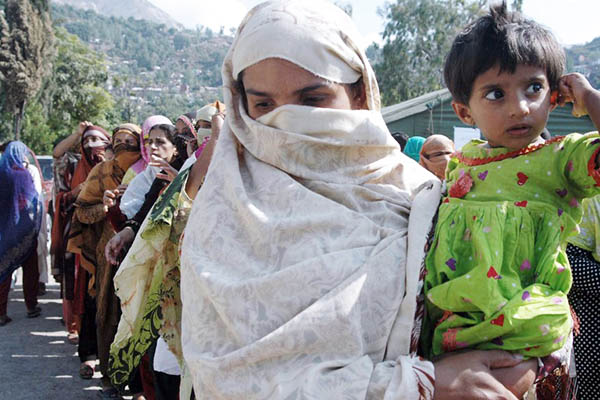
File Photo. Sajjad Qayyum—AFP
Women in Pakistan-administered Kashmir face grim prospects with shortage of doctors, medical facilities.
“We are afraid we could die,” says Asmat Nisa, a mother-of-five set to give birth again. It is a dangerous prospect for women in the remote mountains of Pakistan-administered Kashmir, where doctors are few and help is far.
“There is no hospital here and I have never seen a female doctor,” explains Nisa, who is from the village of Arang Kel in Neelum Valley. That her doctor be a woman is important: local customs dictate that male doctors are not permitted to examine women during pregnancy or labor.
This restriction, combined with the isolation and severe weather of the plunging, remote valleys makes giving birth one of the deadliest moments in the lives of its women and newborns.
“The major reason for the deaths of mothers and newborn babies in the remote areas of Neelum Valley is unskilled and untrained midwives assisting the pregnant women during delivery,” says Farhat Shaheen, director of maternal, newborn and child health for Pakistan-administered Kashmir. Fifty-four babies out of every 1,000 are stillbirths or first day deaths in the region, she said.
In 2014, a report by the charity Save the Children stated Pakistan had the highest rate of first day deaths and stillbirths in the world, at 40.7 per 1,000 births. In Europe, according to the same report, 5.9 babies for every 1,000 do not survive the first 28 days. Even neighboring Afghanistan, torn apart by decades of war, does better than Pakistan, with a rate of 29 first day deaths and stillbirths for every 1,000 births. “The numbers of the deaths are very high,” Shaheen says.
In the village of Sharda, some 20 kilometers from Arang Kel, inhabitants scattered across two mountains face life and death with a single Basic Health Unit (BHU). The facility has one male doctor rendered useless for pregnancy and childbirth by his gender, and three “Lady Health Visitors,” as they are known locally—women whose job is to create awareness about health and hygiene, but who do not give treatment and are not medically trained.
That leaves a lone midwife to help the women of Sharda and the surrounding areas—a population of around 17,000—through childbirth.
The isolation of the region, which is covered with four to five feet of snow in winter, is a significant factor in medical staff’s reluctance to work there, says Dr. Sardar Mahmood Ahmed Khan, director general of health service in Pakistan-administered Kashmir. There is no electricity save a handful of small turbines used to generate hydropower from the streams and rivers sparkling through the valleys—enough to fuel lights, but not much more, even in the BHUs.
Pregnant women fight to scrape a living on the plunging slopes of the unforgiving mountains: carrying wood, cutting grass, working in the fields, says Riffat Bibi, a Lady Health Visitor at the Sharda BHU, adding that poor nutrition is also a factor ruining maternal health. “We have to do our hard daily household routine work during our pregnancies,” adds Rubina Bashir, a mother-to-be in Sharda.
The figures Khan cites are stark: of an estimated 4.4 million people in Pakistan-administered Kashmir, he says there are a mere 1,050 doctors. Some 758 health units—ranging from first aid centers to hospitals—serve the area, with around 3,000 Lady Health Visitors.
Last year, said local resident Habib Ullah, his wife’s delivery ran into complications. His newborn child did not survive the eight-hour journey to a hospital in Muzaffarabad, with its better facilities and larger proportion of women doctors. “My wife was near to death, but she luckily survived,” he says, adding that he had to borrow some Rs. 200,000 to pay the medical bills—roughly 20 times what he earns in a month.
Another Sharda resident, Jahangir Lone, described how his sister-in-law died during the birth of her eighth child. Her husband, he says, could not afford to move her to Muzaffarabad. “If there were any hospital in Sharda where her delivery could have been performed, then her life could have been saved.”
Khan said a special Reproductive, Maternal, Newborn, and Child Health (RMNCH) program launched in 2007 has been offering special incentives to persuade doctors to the area. Doctors who do go, be they men or women, get higher wages than those who work in cities.
The government has fixed the average wage at Rs. 80,000 per month in the rural areas of Pakistan-administered Kashmir, compared to Rs. 65,000 in the towns, Khan said. For specialists the wage in far-flung areas is set at Rs. 150,000, compared to Rs. 100,000 in the cities, he said.
Islamabad had provided Rs. 500 million to run the RMNCH program, run by Shaheen and which sought to train medical staff. But the money, donated in different phases, dried up earlier this year.
Tufail Ahmed, a postman in Kel Sehri village in the outskirts of Shardah town, says his wife had suffered complications during her pregnancy but he could not afford to move her. Their child was stillborn, he says. “I appealed to the government to provide us female doctors in our region so that no one else has to lose his child.”
